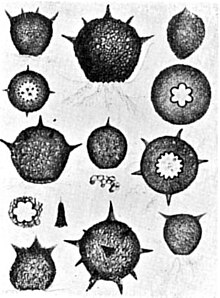Difflugia
| Difflugia | |
|---|---|
 |
|
| Races of Difflugia. (After Leidy.) | |
| Scientific classification | |
| Domain: | Eukaryota |
| (unranked): | Amoebozoa |
| Class: | Tubulinea |
| Order: | Arcellinida |
| Suborder: | Difflugina |
| Family: | Difflugiidae |
| Genus: |
Difflugia Leclerc, 1815 |
Difflugia is the largest genus of Arcellinida, one of several groups of Tubulinea within the eukaryote supergroup Amoebozoa. Arcellinida species produce shells or tests from mineral particles or biogeonic elements (e.g. diatom frustules) and are thus commonly referred to as testate amoebae or shelled amoebae. Difflugia are particularly common in marshes and other freshwater habitats.
The particles used to build the shell are collected by the amoeba directly from the environment, or from their prey. During cell division they pass into the daughter cell, where they are assembled in shape and joined by a sheet-like organic cement. The test has a single terminal opening (the pseudostome). The shape of the shell ranges from spherical to elongated, sometimes with ornamentation such as horns or a collar, sometimes both, as in Difflugia corona.
Difflugia use pseudopods to move around and capture their prey as do other amoeboid protists. Most species of Difflugia are heterotrophs, feeding on organic matter or various prey organisms. Some species however contain endo-symbiotic algae and are therefore mixotrophic, i.e. combining autotrophy and heterotrophy,.
Molecular phylogenetic studies suggest that the genus Difflugia is not monophyletic. The definition of the genus is problematic and future research will most likely result in major taxonomic revision of this group.
...
Wikipedia
